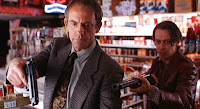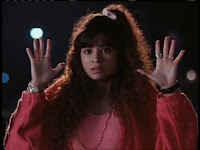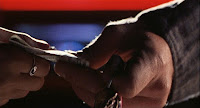It was thirty years ago today that the movie
Twenty Bucks (1993) premiered at the Sundance Film Festival. Unfortunately,
Twenty Bucks (1993) never received a wide release. Fortunately, it was released on VHS. It was also shown on such premium cable channels as Bravo (then a premium channel), Cinemax, HBO, Showtime, and The Movie Channel. Still later it would be released on DVD. Ultimately, it would become a cult film. Much of the reason it achieved cult status may well be its cast, which includes Brendan Fraser, Elisabeth Shue, Christopher Lloyd, and Steve Buscemi. Among the cast was my dearest friend Vanessa Marquez, only a little over a year before she began her stint on
ER.
Twenty Bucks (1993) is a portmanteau film in which many of the various stories overlap. It follows a twenty dollar bill, from its arrival at a bank via armoured car and the various people who come into possession of it to its ultimate demise. Among those people who have the bill for a time is a homeless woman who wants to win the lottery (Linda Hunt), a young man about to marry the boss's daughter, (Brendan Fraser), the owner of a new age shop (Gladys Knight), an underage boy wanting to buy wine (Kamau Holloway), a well-mannered armed robber (Christopher Lloyd), and so on. In many ways it resembles such portmanteau films as
If I Had a Million (1932),
Tales of Manhattan (1942), and
Dead of Night (1945).
The origins of
Twenty Bucks (1993) go back nearly sixty years before it was released. Screenwriter Endre Bohem had written the film
Desert Nights (1929) and would go onto write the film
The House of a Thousand Candles (1936). Still later he would serve as a story consultant and writer on the classic television Western
Rawhide. He had seen the portmanteau film
If I Had a Million, in which a dying millionaire left his fortune to eight total strangers. Endre Bohem thought it would be more interesting to follow a smaller denomination of money pass through the hands of various people. It was then in 1935 that he wrote what would become the first draft of
Twenty Bucks (1993).
It was in the Eighties that Endre Bohem showed the screenplay to his son Leslie Bohem. Leslie Bohem .had been the bassist for the rock band Sparks, but left the band to pursue writing. Leslie Bohem liked his father's screenplay and thought that it would make for a good movie. He then decided to resurrect his father's screenplay. Ultimately, both father and son would share the screeenplay's writing credit.
Karen Murphy, who had produced such films as
This is Spinal Tap (1984) and
Drugstore Cowboy (1989), agreed to be the film's producer. She approached veteran documentary filmmaker Keva Rosenfeld to direct the film. According to an article in
Pop Matters, he decided to direct the movie because "... it was finally a film I wouldn't mind paying to see." As to why they decided upon a $20 bill rather than some other amount, according to Keva Rosenfeld in the same article, "We chose a 20 because in these times it could represent food money for a homeless person for a week or simply tip money for somebody in a restaurant."
It would take some time before the script for
Twenty Bucks would result in a movie. According to an October 17 1993
article in
The Los Angeles Times, Endre Bohem's original script went through several rewrites and even a Sundance Workshop before being "scrapped as being too dated." The final script would depart from Endre Bohem's original script. In both Endre Bohem's original script and his son's rewrite, each story was self-contained, with little to connect them beyond the $20 bill. It was Keva Rosenfeld who thought that the stories should overlap. Over the next two years he worked with screenwriter Leslie Bohem on 18 drafts of the screenplay.
Ultimately, the stories in
Twenty Bucks (1993) would overlap so that a character from one story might appear in another story. Melora Walters plays a stripper at a bachelor party held for Sam Mastrewski (Brendan Fraser), who later shows up as a funeral director. Mark (Noah Lee Margetts) is one of the participants at that same bachelor party. He shows up in a later story offering to buy wine for the underage character Melanie (Vanessa Marquez). Linda Hunt's character, Angeline is largely the thread that runs through much of the movie. She is the homeless woman who initially had the bill and goes throughout the movie trying to buy lottery tickets.
Twenty Bucks (1993) was greenlit without a cast, a remarkable achievement given studios generally want a big-name star attached to a project before they will give the go-ahead. Nonetheless,
Twenty Bucks (1993) would have one of the most remarkable casts of any film made after the Golden Age of Hollywood. Many in the cast were already well-known actors with highly successful careers, including Linda Hunt, Elisabeth Shue, Christopher Lloyd, Steve Buscemi, Gladys Knight, and Diane Baker. Others would achieve stardom in the coming years. Among these were Brendan Fraser, William H. Macy, and David Schwimmer.
As to how a low-budget, independent film like
Twenty Bucks (1993) attracted such remarkable actors, much of it probably had to do with the sheer size of the cast. There were 46 speaking parts alone. For that reason a large number of actors auditioned for
Twenty Bucks (1993). Often, when they did not get the role they wanted, they would simply take a smaller part. Another reason
Twenty Bucks (1993) attracted well-known, established stars and up and coming actors alike is that it gave many actors a chance to play roles that they had never played before. Linda Hunt took the role of Angeline, the homeless woman initially in possession of the $20 bill, because she wanted to play a character who had been "stripped of her authority." Then as now, Linda Hunt was known for playing authority figures. Elisabeth Shue took the role of aspiring writer Emily Adams because she had mainly played girls-next-door and girlfriends in big budget, Hollywood movies. Christopher Lloyd wanted to play the part of holdup artist Jimmy because the character was more lowkey than the previous characters he had played. While Jim Ignatowski on the TV series
Taxi, Doc Brown in the
Back to the Future trilogy, and many of his other characters were often zany and eccentric, Jimmy was quiet, reserved, and even urbane.
Jimmy's fellow holdup artist and partner in crime in
Twenty Bucks (1993) was Frank, played by Steve Buscemi. At the time Mr .Buscemi worried that he was being typecast in criminal roles, so he was initially resistant to playing Frank. It took Keva Rosenfeld some time to convince him to do the role. Ultimately he was happy he did take the part, as it was an altogether enjoyable experience and he got to play opposite Christopher Lloyd, with whom he had never worked before.
As I said at the start of this post, among the large cast of
Twenty Bucks (1993) was my dearest Vanessa Marquez, who played Melanie, the girlfriend of Bobby McComrac, an underage boy who wants to use the $20 bill to buy wine for their dinner. Vanessa never told me how she was cast in the film, but two of the three casting directors on the film (Richard Pagano and Sharon Bialy) were previously casting directors on
Blood In Blood Out (1993), in which Vanessa played Montana's daughter. Appearing in
Twenty Bucks was an altogether pleasant experience for Vanessa Marquez. She really enjoyed playing opposite Christopher Lloyd and Steve Buscemi, and she met most of the other actors working on the film. She also enjoyed working with the film's cinematographer, Emmanuel "Chivo" Lubezki (more on him in a bit).
Twenty Bucks (1993) remained one of Vanessa's favourite projects that she ever did, and she absolutely loved the movie. She described it as "a fun, sweet film."
Twenty Bucks (1993) was filmed on location in Minneapolis, with interiors filmed in Los Angeles, as well as a few locations in LA for actors who could not travel to Minneapolis. Before settling on Minneapolis, the production team had looked at Houston, Dallas, St. Louis, and a few other cities. They wanted
Twenty Bucks (1993) to be set in a large city so that the $20 bill could pass through the hands of a large variety of people. They also wanted it to be set in a classic American city that was not readily identifiable. Among the Minneapolis locations that appear in the film are Minneapolis-Saint Paul International Airport, the 1000 block of West Broadway (where Jimmy and Frank meet), Willwerscheid & Peters Mortuary, and the Marquette Bank.
Twenty Bucks (1993) was shot in 36 days. Because of the short amount of time allotted for filming the movie,
Twenty Bucks (1993) was shot on a very strict schedule. The availability of the actors was always a concern, and scenes had to absolutely finished on time, not only because of the brief shooting schedule, but because one or more of the actors might not be available the next day.
One major concern during the filming of
Twenty Bucks (1993) was the "star" of the film, the $20 bill itself. In reality, multiple $20 bills were used throughout the filming of the movie. The production team got several bills with consecutive serial numbers, as well as bills with the same first few digits and other bills with the same last few digits. This was done so that observant viewers could not tell that it was not the same $20 bill throughout the movie. For the sake of continuity, they had to keep track of how the $20 bill was "marked up" throughout the film (tyre tracks, coffee stains, blood, et. al.). According to Keva Rosenfeld, once they were finished with the bills, they would be put in the production's petty cash fund. In addition to actual $20 bills, they also used bills of various sizes to make shooting some scenes easier. For instance, some bills were much larger than an actual $20 bill.
Money is certainly at the heart of
Twenty Bucks (1993). It was production designer Joseph Garrity who came up with the idea of cluttering the city frames with references to money in the form of murals, advertisements, and so on. The references to money don't stop there. There are radio ads for the lottery, news reports on the stock market, and even a commercial featuring Kevin Kilner as lawyer Gary Adams (who just happens to be the brother of aspiring writer Emily Adams, played by Elisabeth Shue).
As mentioned earlier, the cinematographer on
Twenty Bucks (1993) was Emmauel "Chivo" Lubezki.
Twenty Bucks (1993) was among his earliest American films. One can already see the hallmarks of Mr. Lubezki's style in
Twenty Bucks (1993), from his use of practical lighting to his uncanny ability to frame shots and follow movement. It is largely because of Emmauel Lubezki's work on
Twenty Bucks (1993) that the film actually looks more expensive than it actually was.
As I already mentioned,
Twenty Bucks (1993) premiered at the Sundance Film Festival. That original version was 100 minutes long. It would later be cut down to 91 minutes for its release. At Sundance it was nominated for the Grand Jury Prize-Dramatic (it ultimately went to
Public Access and
Ruby in Paradise--that's right, it was a tie).
Twenty Bucks (1993) would also be shown at other film festivals, including the Seattle Film Festival, the Edinburgh Film Festival, and the Deauville Film Festival, It was at the Deauville Film Festival that it won the critic's award.
Twenty Bucks (1993) not only received recognition at film festivals. Christopher Lloyd won the Film Independent Spirit Award for Best Supporting Male Actor for his role as Jimmy in
Twenty Bucks (1993).
Despite being well received at film festivals,
Twenty Bucks (1993) had difficulty finding a distributor. Ultimately it would be picked up by Triton Pictures, a distribution company that had distributed
Mindwalk (1990),
A Brief History of Time (1991),
Hearts of Darkness: A Filmmaker's Apocalypse (1993), and various foreign films. It opened on October 22 1993 in New York City, Seattle, and Los Angeles. Unfortunately, it was while
Twenty Bucks (1993) was in limited release, on December 7 1993, that Triton Pictures announced that they would be winding down their theatrical distribution by the end of the year. Ultimately,
Twenty Bucks (1993) would never go into wide release.
Fortunately,
Twenty Bucks (1993) would not be relegated to obscurity. It was released on VHS by Columbia TriStar Home Video on June 1 1994. And, as mentioned earlier it aired on various premium cable channels. Even as it was in limited release, it opened the Fort Lauderdale International Film Festival on November 12 1993. Still later, it would be shown at the Austin Film Festival on October 10 1996.
Twenty Bucks (1993) may have never received a wide release, but it would develop a cult following.
As it was,
Twenty Bucks (1993) was in some ways a historic film. Aside from
School Ties (1992), it marked the first time Brendan Fraser played anything approaching a leading role.
Twenty Bucks (1993) would also be the first independent film in which Elisabeth Shue appeared, this after having made several Hollywood movies. David Schwimmer who played Emily Adams's friend Neil, would become a household name only a year later on the TV show
Friends. As mentioned earlier
Twenty Bucks (1993) was one of the earliest American films on which cinematographer Emmanuel "Chivo" Lubezki worked, and his style is already evident in the film.
In many respects,
Twenty Bucks (1993) is very much a film from the Nineties. The film features nudity (the aforementioned Melora Walters's scenes as a stripper), a few instances of violence (none of it very graphic), one scene of drug use, and some strong language. At the same time, it feels as if it belongs to another era. In an already mentioned
Los Angeles Times article on the film, both Leslie Bohem and Keva Rosenfeld say that they "believe the final version is true to the spirit of the original." Legendary critic Roger Ebert agreed with them. In his
review of the movie, he wrote, "Some of the language and situations (like the stripper at the bachelor party) were no doubt not in the original version, but the spirit seems to come through unchanged." I have to say that I always agreed with Vanessa's summation of
Twenty Bucks (1993). It is a sweet, fun film.
Indeed, its script is one of its strong suits. Throughout the film there are references to fate and luck, which make even some of the most unlikeliest ways the $20 bill finds its way into various people's hands seem realistic. The characters are well written, so that even when they appear for only a few minutes they seem like fully realized human beings. Of course, much of that credit must go to the cast. Christopher Lloyd is chilling as Jimmy, a calm character who is much darker than the zany characters he had played before. Steve Buscemi, as Jimmy's more emotional partner Frank, also delivers an excellent performance. Both Brendan Fraser and Elisabeth Shue give admirable performances as young people who aren't exactly sure what they want to do with their lives. Even the supporting actors deliver fine performances. William H. Macy is superb as a police evidence locker clerk who is a bit bemused by his job. Melora Walters does a good job as the stripper who is unhappy with her life and then becomes a funeral director. And while I might be biased, I think my dearest Vanessa Marquez did a fine job as Melanie. Melanie is unlike earlier young characters she played. She is not shy and she is not studious. She is outgoing and is even willing to flirt in order to get wine for her and her boyfriend. Of course, beyond the script and the performances,
Twenty Bucks (1993) is beautifully shot.
Twenty Bucks (1993) is a remarkable film, one that, despite some of its content, seems as if it would have been more suited to the Thirties or Forties than the Nineties. Any one of its stories contain more substance than some entire movies.
Twenty Bucks (1993) had difficulty finding a distributor and it never received a wide release, but somehow it became a cult film anyway. It is easy to understand why.
.jpg)










